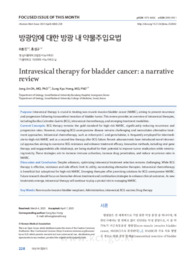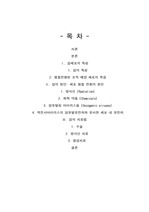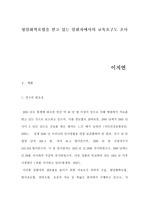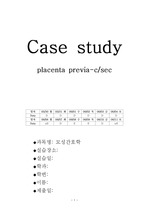

PARTNER
검증된 파트너 제휴사 자료
방광암에 대한 방광 내 약물주입요법 (Intravesical therapy for bladder cancer: a narrative review)
한국학술지에서 제공하는 국내 최고 수준의 학술 데이터베이스를 통해 다양한 논문과 학술지 정보를 만나보세요.
7 페이지
최초등록일 2025.06.05
최종저작일
2025.04

-
미리보기
서지정보
· 발행기관 : 대한의사협회
· 수록지 정보 : 대한의사협회지 / 68권 / 4호 / 228 ~ 234페이지
· 저자명 : 오종진, 홍성규
초록
228 대한의사협회지© Korean Medical Association This is an Open Access article distributed under the terms of the Creative Commons Attribution Non-Commercial License (http://creativecommons.org/licenses/ by-nc/4.0) which permits unrestricted non-commercial use, distribution, and reproduction in any medium, provided the original work is properly cited.
Purpose: Intravesical therapy is crucial in treating non-muscle invasive bladder cancer (NMIBC), aiming to prevent recurrence and progression following transurethral resection of bladder tumor. This review provides an overview of intravesical therapies, including Bacillus Calmette-Guérin (BCG), intravesical chemotherapy, and emerging treatment modalities.
Current Concepts: BCG therapy remains the gold standard for high-risk NMIBC, significantly reducing recurrence and progression rates. However, managing BCG-unresponsive disease remains challenging and necessitates alternative treatment approaches. Intravesical chemotherapy, such as mitomycin C and gemcitabine, is frequently employed for intermediate-to-high-risk NMIBC and as a second-line therapy after BCG failure. Recent advancements have introduced novel intravesical approaches aiming to overcome BCG resistance and enhance treatment efficacy. Innovative methods, including viral gene therapy and nogapendekin alfa-inbakicept, are being studied for their potential to improve tumor eradication while minimizing toxicity. These strategies aim to increase immune activation, increase drug penetration, and reduce recurrence rates in NMIBC.
Discussion and Conclusion: Despite advances, optimizing intravesical treatment selection remains challenging. While BCG therapy is effective, resistance and side effects limit its utility, necessitating alternative therapies. Intravesical chemotherapy is beneficial but suboptimal for high-risk NMIBC. Emerging therapies offer promising solutions for BCG-unresponsive NMIBC. Future research should focus on biomarker-driven treatment and combination strategies to enhance clinical outcomes. As new treatments emerge, intravesical therapy will continue to play a pivotal role in managing NMIBC.영어초록
228 대한의사협회지© Korean Medical Association This is an Open Access article distributed under the terms of the Creative Commons Attribution Non-Commercial License (http://creativecommons.org/licenses/ by-nc/4.0) which permits unrestricted non-commercial use, distribution, and reproduction in any medium, provided the original work is properly cited.
Purpose: Intravesical therapy is crucial in treating non-muscle invasive bladder cancer (NMIBC), aiming to prevent recurrence and progression following transurethral resection of bladder tumor. This review provides an overview of intravesical therapies, including Bacillus Calmette-Guérin (BCG), intravesical chemotherapy, and emerging treatment modalities.
Current Concepts: BCG therapy remains the gold standard for high-risk NMIBC, significantly reducing recurrence and progression rates. However, managing BCG-unresponsive disease remains challenging and necessitates alternative treatment approaches. Intravesical chemotherapy, such as mitomycin C and gemcitabine, is frequently employed for intermediate-to-high-risk NMIBC and as a second-line therapy after BCG failure. Recent advancements have introduced novel intravesical approaches aiming to overcome BCG resistance and enhance treatment efficacy. Innovative methods, including viral gene therapy and nogapendekin alfa-inbakicept, are being studied for their potential to improve tumor eradication while minimizing toxicity. These strategies aim to increase immune activation, increase drug penetration, and reduce recurrence rates in NMIBC.
Discussion and Conclusion: Despite advances, optimizing intravesical treatment selection remains challenging. While BCG therapy is effective, resistance and side effects limit its utility, necessitating alternative therapies. Intravesical chemotherapy is beneficial but suboptimal for high-risk NMIBC. Emerging therapies offer promising solutions for BCG-unresponsive NMIBC. Future research should focus on biomarker-driven treatment and combination strategies to enhance clinical outcomes. As new treatments emerge, intravesical therapy will continue to play a pivotal role in managing NMIBC.참고자료
· 없음태그
-
자주묻는질문의 답변을 확인해 주세요

꼭 알아주세요
-
자료의 정보 및 내용의 진실성에 대하여 해피캠퍼스는 보증하지 않으며, 해당 정보 및 게시물 저작권과 기타 법적 책임은 자료 등록자에게 있습니다.
자료 및 게시물 내용의 불법적 이용, 무단 전재∙배포는 금지되어 있습니다.
저작권침해, 명예훼손 등 분쟁 요소 발견 시 고객센터의 저작권침해 신고센터를 이용해 주시기 바랍니다. -
해피캠퍼스는 구매자와 판매자 모두가 만족하는 서비스가 되도록 노력하고 있으며, 아래의 4가지 자료환불 조건을 꼭 확인해주시기 바랍니다.
파일오류 중복자료 저작권 없음 설명과 실제 내용 불일치 파일의 다운로드가 제대로 되지 않거나 파일형식에 맞는 프로그램으로 정상 작동하지 않는 경우 다른 자료와 70% 이상 내용이 일치하는 경우 (중복임을 확인할 수 있는 근거 필요함) 인터넷의 다른 사이트, 연구기관, 학교, 서적 등의 자료를 도용한 경우 자료의 설명과 실제 자료의 내용이 일치하지 않는 경우
“대한의사협회지”의 다른 논문도 확인해 보세요!
-
이제 우리나라에서 전립선암 국가검진화를 공론화할 적기이다 6 페이지
Purpose: Prostate cancer (PCa) typically occurs in older adults and generally has a relatively long survival period, making it challenging to demonstrate the effectiveness of treatment. In 2012, medic.. -
전이성 방광암의 치료법과 임상적 접근 7 페이지
Purpose: Metastatic bladder cancer has historically been treated with platinum-based chemotherapy as the standard first-line therapy. Since the introduction of cisplatin-based regimens, advancements i..
찾으시던 자료가 아닌가요?
지금 보는 자료와 연관되어 있어요!
문서 초안을 생성해주는 EasyAI







